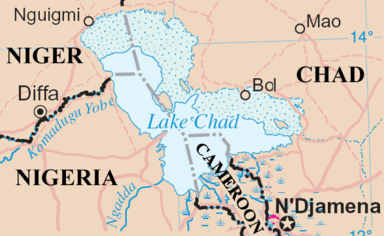Lake Chad is a lake which has varied dramatically over the last few decades. Fifty years ago it was the fourth largest lake in Africa. At that time, it covered 9650 square miles (25,000 square km), however this area has declined a great deal. Currently it is around 386 square miles (1000 square km).

Importantly, as well as being essential for the wildlife in the area, 10 million people also rely on the lake for their water.
Two Biosphere Reserves are currently established in the Lake Chad Basin: Waza (Cameroon) and Bamingui Bangoran (Central African Republic) as well as two World Heritage sites: Manovo-Gounda St Floris National Park (Central African Republic) and Lakes of Ounianga (Chad) protect the wildlife of the area.
There large mammals—such as elephants, hippopotamuses, rhinoceroses, warthogs, giraffes, antelopes, lions, leopards, and cheetahs—coexist with a wide assortment of birds and reptiles. The rivers and the lake are among the richest in fish of all African waters.
Waza national park: One of the parks in the Lake Chad Basin, lies in Cameroon. Situated on the edge of the Sahel it protects 1700 square km, or 700 square miles. The area protected by this reserve includes of both a forested area and a huge expanse of grasslands and seasonal marshes.
30 species of mammal live within the park. There is a small population of west-African lions (these are far rare than the lions elsewhere, and have recently been shown to be the same sub-species as the Asiatic lion. There are several estimates of how many lions are left, it could be as low as 14 or as high as 40 depending – though as this population numbers between 250 and 500 in total, we are talking about10-20% of the population being here. The lion population has suffered from poaching, but the number of guards has been increased which will hopefully give these lions a chance to recover. More importantly, were these lions allowed to recover, it could become a stronghold of the animal. Kob number over 5000 in the reserve, while warthog and Eland are also present. Ostrich have been recorded though rarely seen, Elephants congregate at Mare aux Elephants – which is a famous watering hole. Hartebeest, Tsessebe, Olive baboon, Patas and Vervet monkey, Leopard, Cheetah and nocturnal Aardvark.
There are 379 species of birds which have been recorded in the park.
Threats include a dam on the main river that feeds the park, which has lead to often not enough water. Help from outside has allowed an increase in the number of guards, though it is still requiring one guard per 25 square miles – which is hard when the guards are heavily outnumbered by the poachers.
